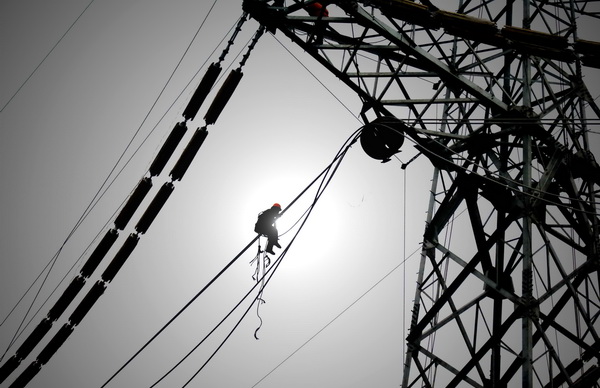


powershortagesCROP
By Yu Huapeng (于华鹏)
Issue 632, Aug 12, 2013
News, page 2
Translated by Zhu Na
Original article: [Chinese]
Since the beginning of the summer, large swathes of China have withered under sweltering temperatures. However, unlike in previous years, there have been few reports of power outages or concerns about power supply being tight.
Aside from a few cases of minor electricity shortages in areas of Jiangsu and Zhejiang province, there have been no signs of shortages in other parts of the country
"Temperatures in Hunan have been particularly high over the past couple of days, it's not been this hot in the past few years,” a senior person from the Xiangtan Power Company told the Economic Observer. “It's already been more than 30 days since Xiangtan (湘潭) has had any rain."
"Hunan has released a ‘code red’ temperature warning, and we've had 39 days of continuous high temperature. It's the most extreme weather conditions we've seen in almost 60 years. Under these conditions, there is little water to power the hydroelectric stations and thermal power plants are needed to make up for the lack of hydropower output."
In Hunan, most electricity is sourced from hydropower plants. Last year and over the first half of this year, the supply of water to power the hydro stations was ample, so most thermal power plants were operating in back up mode. This year, due to the high temperatures, thermal power plants have ramped up power production well ahead of schedule.
"For thermal power companies operating in Hunan, the months of July and August are the peak season for power generation, because these are the two months when the province's electricity consumption peaks and there is also less water to power the hydro stations," a senior staff member from the Hunan branch of China Datang Corporation told the EO.
Given the circumstances - a heat wave occurring right when power plants are operating at full capacity, it would be reasonable to assume that reports of power outages would once again be appearing in the press, but this year there has been a distinct lack of "power shortage" stories.
What's Changed?
We decided to visit a few regions that normally experience severe power shortages - such as the provinces of Jiangxi (江西) and Zhejiang (浙江) and the southern manufacturing base of Dongguang (东莞) - in order to understand what has changed.
Responsible people from a solar water heater company in the city of Jiujiang (九江), a factory in the city of Nanchang (南昌) and a metal product company in Zhejiang all told the EO that they had received notices about power restrictions in previous years, but that they hadn't received any such notices this year.
A responsible person from a printing equipment factory in Dongguang told the EO, "Last year there was a period when electricity consumption was at a peak, and we needed to stagger electricity consumption so that the plant would be open six days and closed on one or open five days and closed on two. This hasn't happened this year and I haven't heard anything about plans to halt or ration electricity supply."
In this regard, some think that the general slowdown in the rate of economic growth across China has led to a decline in electricity consumption and had thus relieved the pressure on electricity supply.
"Electricity consumption in the manufacturing sector is usually a key indicator of whether economic conditions are effecting power consumption. The data from January to June shows that electricity consumed by the manufacturing sector has not fallen," an official from the data and information department of the China Electricity Council (中电联统计信息部) told the EO.
Data from China Electricity Council shows that over the first half of the year electricity consumed by the manufacturing sector increased by 4.8 percent year-on-year, 2.3 percentage points higher than the rate of growth registered in the first half of 2012. Data also revealed that the manufacturing sector was using a record amount of electricity in the month of June 2013.
Shan Baoguo (单葆国), Director of the Institute of Economy and Energy Supply & Demand at the State Grid Energy Research Institute (国网能源研究院经济与能源供需研究所), also told the EO that it was estimated that the summer power shortage would be 7-8 million kilowatts this summer. Looking at the situation now, it's mainly the provinces of Jiangsu and Zhejiang that appear to have a shortage of about 1 million to 2 million kilowatts. Through the orderly use of electricity and demand management, this gap is not so large.
In the summer of 2011, due to high temperatures, low water levels at hydropower stations and a tight supply of thermal coal, some provinces experienced major power shortages.
Shan Baoguo said there were four main reasons why this year's power shortages are less severe than 2011.
The first is that there has been an overall slowdown in demand for electricity.
A second reason is that installed power generation capacity is growing at a quicker pace. From Sept 2011 to June this year, the national new installed power generation capacity reached 153 million kilowatts, faster than the speed at which demand for electricity is expanding.
Thirdly, inter-provincial electricity transmission capacity has improved.
The official from the Hunan branch of Datang quoted above explained to the EO that "one of the major reasons why Hunan won't experience power shortages this year is that last year Hunan signed a power purchase agreement with Guizhou province. Last year they already ordered the electricity supply for this summer."
Finally, the price of coal used for power generation has decreased, which has meant that thermal power output hasn't been restrained by coal shortages.
Shan Baoguo also predicted that "given the outlook for development, the likelihood that thermal coal prices would shoot up again is quite small, only if there was to be another 4 trillion yuan stimulus package introduced or something like that would it occur. Therefore it's unlikely that large scale power shortages will occur again."
EO Reporter Yu Han (余寒) also contributed to this story.

